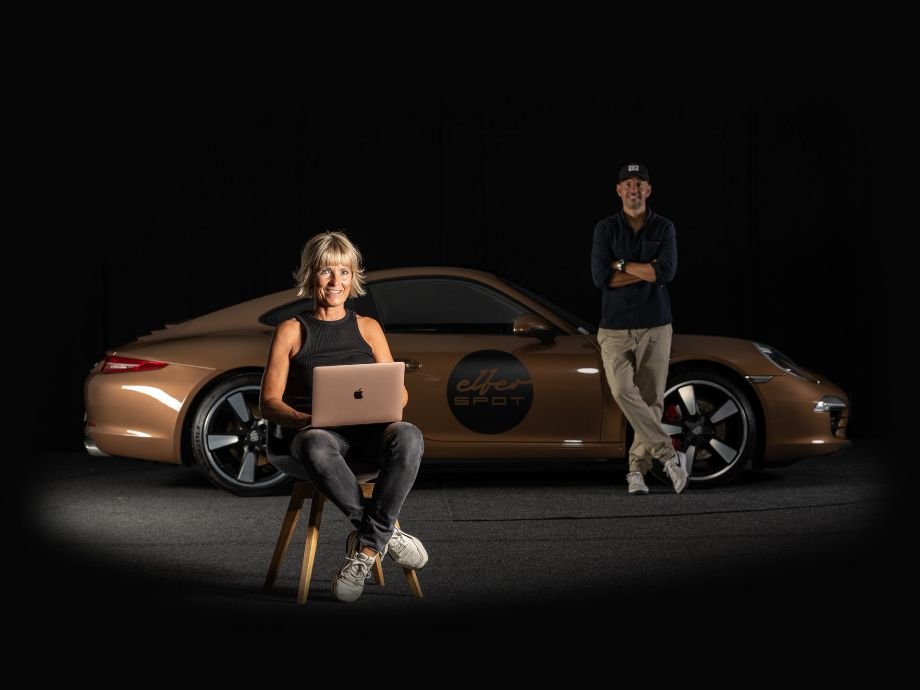This car, Chassis 5511, is one of the last four digit Split-Windshields produced. It was completed on March 6th, 1951- just two weeks before the 500th Porsche 356’s manufacture date of March 21, 1951. It was delivered with the rare early-style grooved aluminum bumper deco trim, reclining passenger seat, and ultra-rare Telefunken Lightning Bolt radio and Petri Pealit steering wheel. The Fish Silver Grey Metallic paint that it left the factory in was originally made with real fish scales. It was sold brand new to Hans Müller-Kray who was the conductor of the Stuttgart Radio Symphony Orchestra. It was brought to America by a U.S. serviceman in 1955 after acquiring it from Mr. Müller-Kray.
The American GI imported #5511 into New York in the mid-1950’s and drove it to his home in Oklahoma. Not long after returning home, the GI wrecked #5511 and had it towed to a local repair shop. After sitting in the repair shop for a year, #5511 was eventually sold to the sheriff who initially came to the scene of the accident. The sheriff towed #5511 home and parked it on his farm in Oklahoma where it remained for over three decades.
Split-Window expert and registry founder Thomas Birch discovered it on a farm in Hastings, Oklahoma in 1992. Incredibly, chassis #5511 was intact and even had some original paint left on it. Mr. Birch proceeded to restore #5511 and sold it to the FIA owner, Tetsuya Shimada, and was exported to Japan shortly after the restoration. In 2001, Phil Bagley acted as a broker and sold #5511 to Neil Huffman. #5511 was then imported from Japan and was featured in Huffman Collection until 2009, whereupon Road Scholars purchased it.
Chassis 5511’s painstaking restoration took thousands of man-hours of research and execution of factory details of how these cars were constructed in 1951. Original components were sourced from around the globe and as a result, no reproduction components were used in its restoration. for instance, an original broken early Porsche script was sourced for the nose of the car. The Road Scholars team sand-cast it and smelted World War II German canteens to replicate the quality of the aluminum. Thus, the finished script has the same flawed casting details and porous aluminum look as the original. Many of the original chassis and sub-assembly panels were made from scratch using the originals as templates. Countless hours were spent repairing the degraded original transmission housing and engine magnesium cooling fins.
As no reproduction sheet metal parts with the correct details exist, a digital scan of chassis 11260 was completed so a wooden body buck could be made in order to fabricate the correct body panels that were necessary to complete the restoration. This included the proper embossed mounts for the turn signal and reflectors on the rear bodywork. The panels were spot-welded into place as was factory procedure. Once epoxy primed and painted in Fish Silver Grey Metallic, red oxide primer was applied to the interior replicating the original factory finish and undercoating with a coarse texture was applied to the underside of the chassis.
The seats were constructed in the same fashion as they would have been in the early 1950s, with coconut fiber stuffing and burlap stitched together by hand and upholstered with Bedford wool cord and vinyl. The headliner was finished with a grey-blue wool-cotton fabric and the floors were finished with the correct early production VW grooved rubber trim and blue square weave carpeting. The Telefunken radio was restored to its original finish, and each of the rare ivory VW switches and turn signal were either sourced or restored to their original condition.
Chassis #5511 was displayed for the first time after its restoration at the 2020 Amelia Island Concours where it was awarded the Craftsman/Phil Hill Restorer’s award for the best new restoration as well as the third-place award from the Hagerty Youth Judges.
Chassis #5511 is an important milestone Porsche history and its painstaking restoration pays homage to Ferdinand Porsche’s vision of “what a modern sports car should be”, as well as the designers, engineers, and craftsmen who were responsible for setting the high standard of quality and road handling that Porsche cars became synonymous with.

























































































